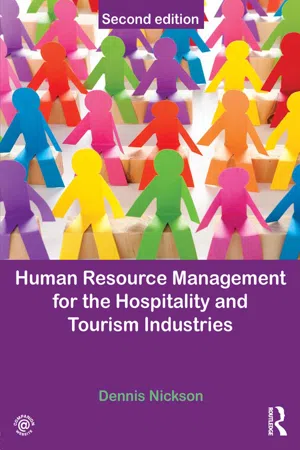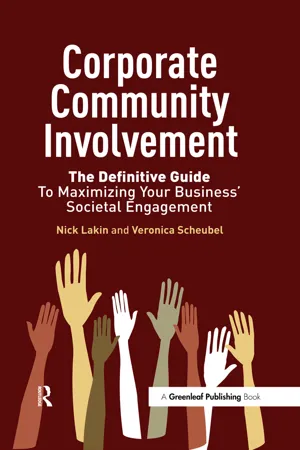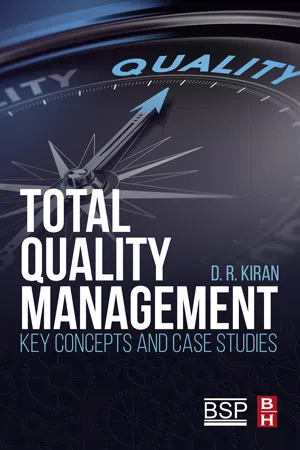Employee Involvement
Employee involvement refers to the active participation of employees in decision-making processes, problem-solving, and goal-setting within an organization. It encompasses empowering employees to contribute their ideas, feedback, and expertise to improve work processes and outcomes. This approach fosters a sense of ownership, commitment, and motivation among employees, ultimately leading to increased productivity and job satisfaction.
8 Key excerpts on "Employee Involvement"
- Su Mi Dahlgaard-Park(Author)
- 2015(Publication Date)
- SAGE Publications, Inc(Publisher)
...Employee Involvement Employee Involvement 196 199 Employee Involvement Employee Involvement refers to various initiatives intended to involveemployees more closely in the running of the enterprise where they work.Employee Involvement is a generic term that refers to the directparticipation of employees to help their organization better fulfill itsmission and meet its objectives by applying their own ideas, expertise, efforts, anddecision-making skills toward initiatives that can range from solving minorproblems to setting corporate policies. Also known as workers’ participation, Employee Involvement has been promotedfrom all sides of the ideological spectrum. On the left, it appeals to anincreased participation by labor and/or its representatives in the corporatedecision-making process, leading at times to full worker control andself-management. It considers labor to be as much a partner and shareholderin private enterprise as capital and, therefore, deserving of similarrepresentative rights. On the right, it helps inculcate feelings of loyalty,ownership, and commitment among workers in the business where they work;improves job satisfaction and morale; reduces absenteeism and workerturnover; supports worker creativity and innovation; and is sympathetic toworker cooperatives, where the workers are the owners. This entry first describes the various forms of Employee Involvementinitiatives and then presents a critical analysis of the practice. Forms of Employee Involvement Employee Involvement can take various forms, and their popularity dependson culture, support mechanisms in place, economic prospects, andhistorical context. The most common variants are discussed in turn, andin increasing degrees of actual worker power and influence over decisionmaking. Employee (or staff) suggestion schemes involve the active encouragement of employees to submitsuggestions for the improvement of work organization tomanagement...
- Dennis Nickson(Author)
- 2013(Publication Date)
- Routledge(Publisher)
...Hyman and Mason (1995) suggest that, increasingly, talk of industrial democracy — which denotes a fundamental change in the balance of power in society generally and the workplace specifically, such as the establishment of employee self-management — has little currency in contemporary market-driven economies. Consequently, we are left with the notions of ‘Employee Involvement’ and ‘employee participation’, which represent the ‘two principal and in many respects contradictory approaches to defining and operationalizing employee influence’ (Hyman and Mason, 1995: 1). Employee involvemer Marchington and Wilkinson (2005b) recognize that there are a number of mechanisms that have been introduced under the broad heading of Employee Involvement, such as team-working and empowerment, to name just two. While there may be a number of differing initiatives, there is nonetheless common agreement on the intent of Employee Involvement. In that sense most writers recognize that Employee Involvement is concerned with measures that are introduced by management to optimize the utilization of labour while at the same time securing the employee's identification with the aims and needs of the organization. Employee Involvement is seen as being very much a phenomenon of the 1980s and closely linked with ‘soft’ HRM and its emphasis on unitarism and the creation of common interests between employer and employee. Employee Involvement is managerially initiated and characterized as direct, ‘descending participation’, which is task-centred as it attempts to involve all individuals in the workplace (Salamon, 2000). In this way it seeks to provide employees with opportunities to influence and take part in organizational decision-making, specifically within the context of their own workgroup or task. Therefore it is intended to motivate individual employees, increase job satisfaction and enhance the sense of identification with the aims, objectives and decisions of the organization...
- eBook - ePub
- John Gennard, Graham Judge, Tony Bennett, Richard Saundry(Authors)
- 2016(Publication Date)
- CIPD - Kogan Page(Publisher)
...The amount of influence employees have in decision-making, in particular, is regarded as important because it is likely to shape broader organisational outcomes (Marchington et al, 1992). Employee Involvement is generally seen as directed at individual employees. By introducing Employee Involvement mechanisms, management seeks to gain the consent of the employees to their proposed actions on the basis of shared objectives rather than purely control (Walton, 1985; Hyman and Mason, 1995). These mechanisms are aimed at enabling individual employees to inform management decision-making processes. Typically, they are based on management sharing information directly with individuals or groups of employees in return for their views. Alternatively, Employee Involvement (EI) can also involve ‘task-based’ control of decision-making for employees at the individual job level of the organisation. This encompasses the notions of ‘job enlargement’ and ‘job enrichment’ (Dundon and Wilkinson, 2013: 492). Although critics might rightly suggest that these types of EI initiatives remain largely unitarist in design, it can also be argued that they increase job satisfaction by reducing the routinisation of work and allowing greater autonomy. However, Employee Involvement is not about employees sharing power (jointly regulating the employment relationship) with management; the decision whether to accept, or reject, the views of the employees rests with management alone. In contrast, employee participation concerns the extent to which employees play an active role within the decision-making machinery of the organisation. This is generally achieved through indirect collective representation in the form of joint consultation, collective bargaining and board-level worker representation. These systems focus on collectively representative structures (Hyman and Mason, 1995)...
- eBook - ePub
Corporate Community Involvement
The Definitive Guide to Maximizing Your Business' Societal Engagement
- Nick Lakin, Veronica Scheubel(Authors)
- 2017(Publication Date)
- Routledge(Publisher)
...8 The power of Employee Involvement Employee Involvement is an integral part of your Community Involvement strategy. It is the personal involvement of employees in the communities where they work and live that will make your Community Involvement come to life. Employee Involvement is a “triple win” for employees, communities, and the company. It provides communities with much-needed help, motivates employees in their day-to-day work, and increases corporate image and reputation. It can also be activated as a strategic HR tool. The chapter starts with a best-practice interview with a leading practitioner and then helps you understand better what Employee Involvement is and how you can make the Business Case for it. A practical five-step process with detailed checklists will then help you pursue a structured approach to designing your own Employee Involvement initiative. Getting management and employees on your side For many companies, especially in the US and the UK, volunteering is part of the national culture. For them, the value of Employee Involvement is self-evident. In cultures less familiar with Employee Involvement, you may need to argue your case to get Employee Involvement started in your company. Senior management may question whether employees will be interested, or how much it will cost the company to give employees paid time off for volunteering. Experience shows that the interest from employees is always there, in every country where a company operates. Even if your company has just five employees in a given country, they will appreciate the opportunity to contribute to their community on behalf of the company. Even skeptical managers have found that employees want and support volunteering with great enthusiasm and commitment. Interview with Thomas Baumeister: Generating real commitment Thomas Baumeister is Head of Volunteering, Region Germany, within Deutsche Bank’s Corporate Citizenship unit...
- eBook - ePub
Total Quality Management
Key Concepts and Case Studies
- D.R. Kiran(Author)
- 2016(Publication Date)
- Butterworth-Heinemann(Publisher)
...Make SWOT analysis of yourself with respect to the issue. 2. Know your employee or the workforce, their attitudes background, etc. 3. Establish a positive attitude. 4. Share the goals. 5. Monitor the progress. 6. Develop intersecting work by job rotation, job enlargement, and job enrichment. 7. Communicate effectively. 8. Celebrate success. 11.10 Benefits of Employee Involvement Besterfield cites the following benefits of Employee Involvement and participative management: 1. Employees make better decisions using their expert knowledge and skills in the process. 2. Employees are more likely to implement and support decisions if they had a part in making them. 3. Employees are better able to spot and pinpoint areas for improvements. 4. Employees are better able to make immediate corrective action. 5. Employee Involvement reduces the labor/management friction by encouraging more effective communication and cooperation. 6. Employee Involvement increases the morale by creating a feeling of belonging to the organization. 7. Employees are better able to accept change because they control the work environment. 8. Employees have an increased commitment to unit goals because they are. involved. Peter Grazier puts the following points in favor of total Employee Involvement. 1. Everyone has something to contribute and will, if the environment is right. 2. The human element performance is more important than the technical element. 3. Most decisions can be significantly improved through collaboration. 4. People need leaders. Good leaders build trust and a higher sense of mission and source of worth. 5. Employee Involvement is not a program. It is a corporate philosophy. 6. Continuous improvement is beautifully simple. As improvements begin to flow, confidence will build and the progress will feed on itself. 11.11 Role of Senior Management in Employee Involvement In Chapter 4, we have seen several types and qualities of senior management...
- eBook - ePub
The Psychology of Employee Empowerment
Concepts, Critical Themes and a Framework for Implementation
- Rozana Ahmad Huq(Author)
- 2016(Publication Date)
- Routledge(Publisher)
...A number of authors argue that clearly it is power-sharing which differentiates employee empowerment from Employee Involvement and participation (Ford and Fottler, 1995 ; Wilkinson, 1998 ; Lashley, 2001 ; Martin, 2005). Other authors, such as Psoinos and Smithson (2002 : 134), propose that the main difference between Employee Involvement, participation and Employee Involvement is to do with the ‘transfer’ of decision-making authority, as explained below: Whereas in both involvement and participation, management retains control, in empowerment employees have – at least to some degree – authority to make and implement their own decisions. Employee Involvement (EI) is defined by Fincham and Rhodes (2005 : 437) as: ‘a recent movement of work improvement … which emphasises a wide range of methods including communications and changes in work culture, as well as work redesign’. In their investigation they found that, although not dramatic, changes in work design allow low levels of input from employees, as there were ‘some signs of a move away from strictly Taylorist methods towards more broadly based work flows’ (Fincham and Rhodes, 2005 : 436); but there is no power-sharing involved. Employee Involvement is as it states, simply an involvement of employees in organisational strategy or decisions. It is important to note that it is only an ‘ involvement ’; it does not mean that management allows strategic decisions to be taken by employees, as in employee empowerment. Even participation is viewed by several authors as at best a ‘consultative’ process without any real sharing of power (Arnold and Feldman, 1986 ; Hellriegel et al., 1989). For example, ‘Participative leadership characterises a leader who, when faced with a decision, consults with subordinates, solicits their suggestions, and takes ideas seriously in arriving at a decision’ (Arnold and Feldman, 1986 : 131). However, it is the leader who actually takes the decision in the end...
- eBook - ePub
Human Resource Management at Work
The Definitive Guide
- Mick Marchington, Adrian Wilkinson, Rory Donnelly, Anastasia Kynighou(Authors)
- 2020(Publication Date)
- CIPD - Kogan Page(Publisher)
...The Bullock Committee’s approach had several distinctive features. It was partly union-initiated, through the Labour Party, and based on collectivist principles that saw trade unions playing a central part in future arrangements. In addition, it was wedded to the general principle of employee rights established on a statutory basis (Ackers, 2019). Thus, from this perspective, participation can be seen as a fundamental democratic right for workers to extend a degree of control over managerial decision-making in organisations. Over the last 30 years, we have seen the emergence, and continuing growth of a rather different animal – Employee Involvement and participation (EIP) (Marchington, 2015b; 2015c). This arose in a context of reduced union power and an anti-corporatist Thatcher government during the late 1980s which resisted statutory blueprints and encouraged firms to develop the arrangements which best suited them. This agenda was quite different from the previous period in several ways. First, it was management-initiated, often from outside the employment relations sphere, and with scant reference to trade unions. Second, it was more individualist, and stressed direct communications with individual employees. Third, it was driven by business criteria concerning economic performance and the ‘bottom line’, with an emphasis on employee motivation and commitment (Dundon and Wilkinson, 2020). Dutiful compliance and following rules no longer described the ‘good worker’; instead, management demanded employee commitment, working beyond contract and exercising initiative. The notion of high-commitment HRM (see Chapter 3) made the case that long-term competitive advantage could only be achieved through people. The term ‘employee voice’ is also used in the literature in this area, sometimes interchangeably with EIP (Barry and Wilkinson, 2015; Wilkinson, Barry et al, 2020)...
- eBook - ePub
- Owen Hargie, Dennis Tourish, Owen Hargie, Dennis Tourish(Authors)
- 2004(Publication Date)
- Routledge(Publisher)
...11 Conceptualizing Involvement, Participation and Workplace Decision Processes A Communication Theory Perspective Stanley Deetz and Devon Brown Introduction Numerous writers have argued that we have entered an ‘age of participation’, suggesting a distinctively new way of managing and making decisions together. In discussing communication more generally, the various essays in this volume have outlined the many conditions pushing increased participation in workplace decisions, the forms and practices of participation, and the consequences for business and society. Still, workplace participation has been constrained (Heckscher, 1997; Wisman, 1997). And, where it has occurred it has been most often limited to employee participation. Institutional relationships, vested interests, and both overt and subtle power relations, have provided clear barriers to widescale productive participation in business decisions. We, among many others, have tried to address such issues in other places (for example, Deetz, 1992, 1995b; Wagner, 1994; Cheney et al., 1998; Seibold and Shea, 2001). In this chapter, we wish to present a theoretical perspective on the issues involved. Our focus is upon what might appear to be more benign communication conceptions and practices that nonetheless have tremendous impact on the success and viability of participation programmes. The form and practices of participation, not just its existence, matter (Russell, 1997). Communication is an integral part of any form of participation. Workplace participation of various forms is important for all types of organizations. The core concepts of stakeholder representation, enhanced creativity, and positive communicative practices apply to for-profit businesses, public agencies and not-for-profit groups. The central questions – ‘Whose objectives should count?’ ‘How much should they count?’ and ‘How will they be accounted for?’ – arise in all modern organizations...







